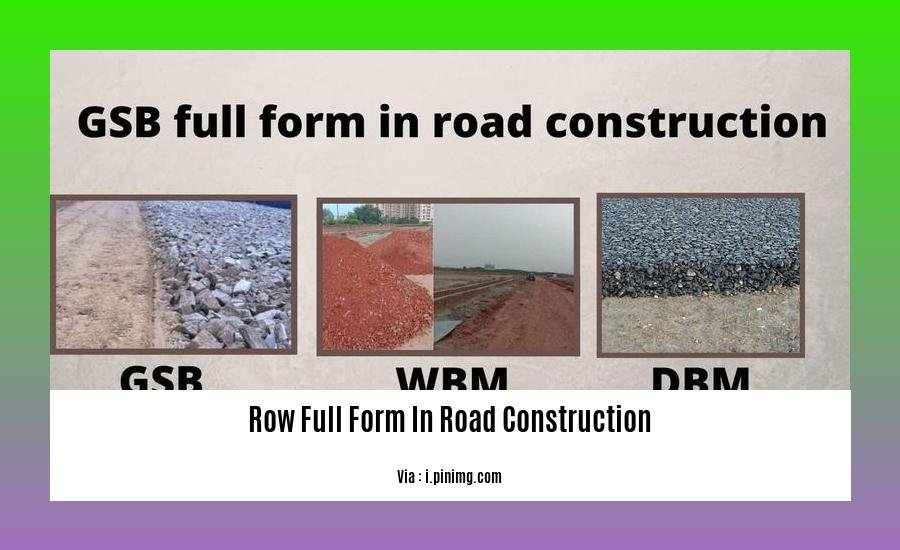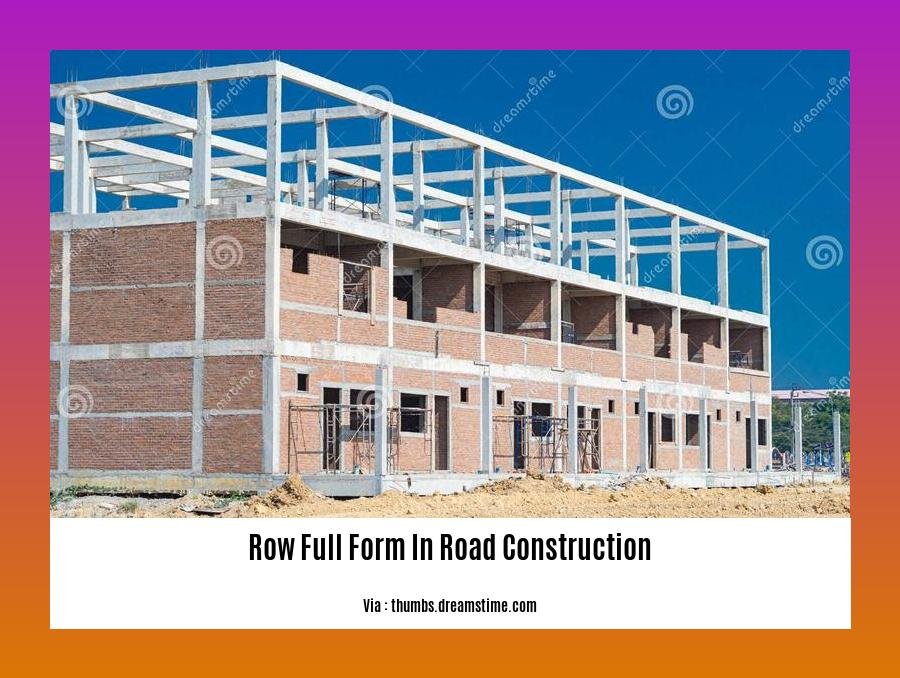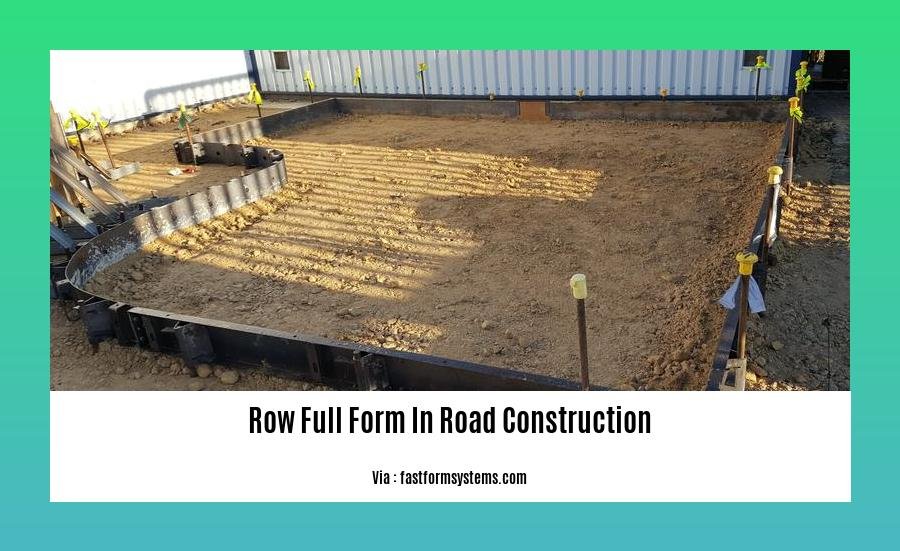Delving into the realm of road construction, one frequently encountered term is “ROW.” In this article, we decipher the meaning of ROW, commonly known as “Right of Way,” and explore its significance in the intricate world of road construction. Stay tuned as we unravel the purpose and implications of ROW, providing a comprehensive understanding of this crucial concept.
Key Takeaways:
- Definition: ROW (Right of Way) is a legal easement that allows access to land for transportation or utility purposes.
- Purpose: ROW is used to provide public access to roadways, railways, sidewalks, and utility lines (such as drainage, electricity, and gas).
- Acquisition: ROW land is typically acquired for the width of the roadway as well as future expansion and other necessary purposes.
ROW Full Form in Road Construction: Right of Way Explained

What is ROW in Road Construction?
Definition:
ROW stands for Right of Way, which refers to a legal easement granted over land for the purpose of transportation or utility infrastructure. This publicly owned land is designated for streets, sidewalks, power lines, drainage systems, and other utilities.
Types of ROW:
- Public ROW: Land owned by the government for public use, such as roads and sidewalks.
- Private ROW: Land owned by private entities, such as utilities, for the installation and maintenance of infrastructure.
Purpose of ROW:
The primary purpose of ROW is to provide:
- Space for the construction and maintenance of transportation and utility infrastructure.
- Safe and efficient movement of vehicles and pedestrians.
- Sufficient area for future expansion and improvements to infrastructure.
Importance of ROW:
ROW is crucial for the development and sustainability of communities:
- Connects people and businesses, facilitating commerce and social interaction.
- Enhances transportation efficiency, reducing travel times and costs.
- Improves safety by separating pedestrians and vehicles.
- Provides space for utilities that support essential services, such as electricity, water, and telecommunications.
Acquisition of ROW:
ROW is typically acquired through negotiation with landowners or eminent domain, a legal process that allows the government to take private property for public use. Compensation is provided to landowners for the value of the acquired land and any resulting damages.
Maintenance of ROW:
Proper maintenance of ROW is essential for the safety and functionality of transportation and utility infrastructure. This includes:
- Regular inspection and repair of pavement, sidewalks, and drainage systems.
- Removal of debris, vegetation, and snow.
- Enforcement of traffic regulations and parking restrictions.
To know more about the different meanings of retention in construction, click here to learn more about what it is, here to understand its context in contracts, and even here to get a general idea. You can also click here to learn more about the term in general.
For those interested in construction industry-related roles, click here to learn about the role of plumbers. Additionally, you can click here to understand the term “row” in road construction.
ROW Design Considerations

Right-of-Way (ROW) refers to the land set aside for road development, including the road itself, utilities, and potential future expansions. Designing the ROW involves careful consideration of several key factors:
-
Access and Safety: ROW design should ensure safe and efficient access for vehicles, pedestrians, and cyclists. Factors like sight distance, intersection design, and pedestrian crossings need to be accounted for.
-
Drainage: Proper drainage is crucial to prevent flooding and road damage. ROW design must incorporate drainage systems that effectively manage stormwater runoff.
-
Environmental Impact: Road construction can impact the surrounding environment. ROW design should minimize negative impacts on wildlife, vegetation, and water resources through measures like revegetation, erosion control, and wildlife crossings.
Key Takeaways:
- ROW design considerations include access, safety, drainage, and environmental impact.
- ROW width varies based on road type and traffic conditions.
- Transmission line design in ROW areas requires careful planning to prevent interference with road operations.
Relevant URL Sources:
– Right of Way – Definition & Factors Affecting ROW
– Transmission in Highway ROW: Design Considerations
ROW Maintenance and Management
Have you ever thought about the area of land surrounding a road, beyond the paved surface? That’s what we call the “Right of Way” (RoW). It’s like the strip of property that allows engineers to do their magic and build us these crucial roads.
ROW Maintenance and Management: The Unsung Heroes
Just like our own homes need upkeep, roads require constant care to keep them safe and efficient. ROW maintenance and management play a vital role in this process. It’s about safeguarding the integrity of our roads and ensuring they’re always ready to go. Think of it as the guardian angels for our asphalt friends.
Keeping an Eye on ROW
Imagine a little bird flying high above the road, keeping a close eye on everything. That’s what ROW maintenance teams do. They check for:
- Vegetation control: Trimming trees, removing weeds, and clearing brush to prevent accidents and ensure visibility.
- Drainage maintenance: Cleaning ditches and culverts to drain water properly and avoid flooding.
- Signs and markings: Inspecting and replacing damaged signs, repainting faded markings, and installing new ones for safety.
Managing ROW
Now, let’s get a bit technical. ROW management is the systematic process of planning, designing, and implementing ROW activities. It involves:
- Acquiring ROW: Buying or leasing land from property owners for road construction.
- Planning ROW: Determining road alignment, width, and access points to minimize impact on the surrounding environment.
- Protecting ROW: Enforcing regulations to prevent unauthorized access, encroachment, or damage to the ROW.
Key Takeaways:
- ROW maintenance and management ensure safe and efficient roads.
- ROW maintenance focuses on vegetation control, drainage maintenance, and signage.
- ROW management involves planning, acquiring, and protecting land for road construction.
Relevant URL Sources:
- AboutCivil.Org: Right of Way – Definition & Factors Affecting RoW
- Wikipedia: Right-of-Way (RoW) Management
ROW Legal and Regulatory Framework
Key Takeaways:
- ROW Legal and regulatory framework provides the foundation for successful road construction projects.
- Compliance ensures efficient project implementation by addressing concerns related to sanctions, inefficiencies, and resource constraints.
- Understanding the acquisition of right-of-way (ROW) is essential, encompassing various property types such as private, public, and pipeline.
ROW Legal and Regulatory Framework in Road Construction
The success of road construction projects hinges upon compliance with established regulatory frameworks. These frameworks provide clear guidelines for the acquisition of right-of-way (ROW), the strip of land necessary for road construction. By adhering to these frameworks, projects can avoid potential pitfalls and ensure smooth implementation.
Compliance with ROW Legal and Regulatory Framework
Compliance is paramount for effective project implementation. Key factors that bolster compliance include:
- Clear sanctions for non-compliance, ensuring accountability.
- Streamlined processes and procedures, minimizing inefficiencies.
- Adequate resources and support, facilitating compliance.
Types of ROW
ROW encompasses various property types:
- Private property ROW: Acquired from private landowners through negotiation or eminent domain.
- Public property ROW: Obtained from government agencies, often through transfer or lease.
- Pipeline ROW: Designated for the installation and maintenance of pipelines.
Compliance and Procurement Regulations
Regulatory frameworks also mediate the relationship between road construction project implementation and performance. Procurement regulations, for instance, ensure fair competition, transparency, and accountability in the awarding of contracts. Compliance with these regulations promotes efficiency, cost-effectiveness, and integrity in project execution.
References:
- Compliance within a Regulatory Framework in Implementing Public Road Construction Projects
- Compliance mediating role within road construction regulatory framework
FAQ
Q1: What does ROW stand for in road construction?
A1: ROW stands for Right-of-Way, which refers to the area of land acquired for road development, including carriageways, utilities, and future extensions.
Q2: What are the purposes of a ROW?
A2: ROWs are used for various purposes, including roadways, railways, sidewalks, drainage systems, and utility lines (electricity, telecommunications, oil/gas).
Q3: What are the important points to consider in ROW design?
A3: ROW design considerations include access, safety, drainage, environmental impact, and future development needs.
Q4: What is the typical ROW width for a 4-lane road in India?
A4: In India, the ROW width for a 4-lane road is typically 45 meters.
Q5: What are the different types of ROWs?
A5: The main types of ROWs are private, public, property, and pipeline ROWs.
- Annapolis Mall Map & Directory: Find Stores, Restaurants & More - March 29, 2025
- Angel of Harmony Statue Vandalized at St. Louis Cathedral Basilica - March 29, 2025
- Amur River Maple ( Acer ginnala): A Comprehensive Guide (Including Invasiveness) - March 29, 2025










